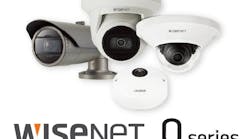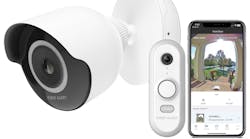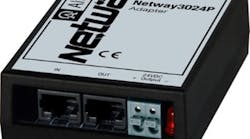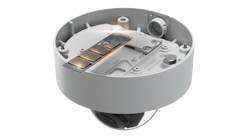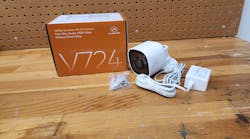Wherever there is new construction, it is likely that surveillance systems will be installed. Modern surveillance equipment is relatively inexpensive, reliable and effective for preventing crimes as well as providing visual evidence of a crime.
Buildings equipped with external surveillance cameras are less likely to be attacked by vandals and burglars. This is because surveillance equipment is usually advertised for legal reasons as well as preventative reasons. Thieves and vandals are on notice that cameras are present and video is being captured. This is especially advantageous when working in tandem with other systems (i.e. alarm systems, exterior lighting, heavy duty locks) that enhance the security profile.
Captured video is a reliable tool used to send criminals to jail, so thugs simply avoid buildings protected by surveillance cameras. Parking lots under surveillance are less likely to have vehicles broken into or vandalized. Passive loss prevention is implemented, as employees are aware the working environment is under surveillance.
Properly captured video is a valuable resource for building owners and company managers when litigation or libelous claims need to be addressed.
It wasn't that long ago that videotape was the only practical means of recording and storing captured video. There were drawbacks:
• Every four-to-five days, someone had to go to the recorder and change the tape.
• Tapes were often recorded over, degrading the viewing quality.
• To get days of duration, recorders were usually set to “super-long play,” resulting in single frames of capture and missed details between frames.
• Tapes often snagged or snapped.
• Motors, gears, and rollers within the recorder would wear out from constant use.
• Reviewing the tape was grueling as it required time-consuming fast-forwarding and rewinding.
Recording more than one camera at a time required an additional piece of equipment, a multiplexer or quad.
In a modern day standalone DVR, the only part that moves is the recording head built-into the hard drive. Even then this is only periodic. Video is stored into RAM (temporary memory) and written to the hard drive only as needed. Fewer moving parts equate to reliability.
Video from the hard drive can either be manually or automatically downloaded. An external storage device or laptop can download video at the location. The DVR can be connected to a network where video can be transferred.
Transferring video across a network can be automatically scheduled.
Digital video does not degrade. When properly encrypted, downloads cannot be “doctored” so capture video holds up in court.
The standalone DVR is designed to accommodate just about any type of input or output device available. The DVR will accept all surveillance-type cameras and microphones. The DVR can output to computers, printers, and monitors. Signals from sensors can trigger DVR activity. Signals from the DVR can signal security alarm, fire detection and building automation systems.
The DVR is the heart of the surveillance system and it is essential to protect it.
Most buildings today have a storage room dedicated to communication and electrical equipment. Electrical circuit breakers, telephone lines and computer servers are accessible and grouped. Typically fire, alarm and security controllers are installed here to gain access to conduits and the room is well protected.
The DVR in Figure 2 is mounted in the corner of the communication room. The door is self-closing, self-latching, and protected with a storeroom function lock with the operations manager having exclusive access.
Figure 3 is a close up of the monitor attached to the DVR. It is not necessary attach a monitor to the DVR while it is working, but a 19” flat screen costs less than $200 and provides a convenient means to check that all cameras are working as expected.
The part of the screen shot that is circled represents the video steam from Camera #9. This camera surveys part of the south parking lot. Because 16 cameras are being monitored at one time, little detail is available from the screen shot.
Figure 4 is a full shot from Camera #9 and includes a PIP (picture-in-a-picture) of the license plate of a car. This camera has been set to “normal” regarding picture quality. Where normal picture quality is good enough for long views, the lack of resolution is not sufficient enough to zoom in on the license plate and make out any kind of detail.
To successfully capture license plates from a distance, the resolution needs to be turned up for Camera #9. In Figure 5, the PIP clearly reveals the license plate details. The camera was reset from “normal” to “superfine.”
Although this produces superior results, it also requires more storage because of the higher resolution. If all cameras are set to normal, the total amount of storage allocated per day would be 158GB (Gigabytes). If the total amount of available hard drive space is 800GB, then 5.1 days can be recorded. If all cameras are set to superfine, the size of the daily file will be 277GB. This limits the days that can be recorded on the same hard drive to 2.9.
This DVR features two internal 800GB hard drives and a CD-R reader/writer. All cameras are set to superfine (maximum resolution) as there is a passive procedure guaranteeing that all video is properly stored. Downloads are performed automatically, after hours, and are saved on a network server dedicated to data backups.
Calculating storage time
The key to determining storage time is the size of a single frame. From that, there is an equation that can be performed to determine the hard drive size or the amount of days of storage a hard drive can store.
The chart in Figure 6 is set up for a DVR that handles 16 cameras, set at “superfine” picture quality, at 7.5 Frames Per Second. The equation at the bottom of the chart can be used to determine storage for different settings.
For instance a dry cleaner might use a DVR that manages two cameras, each set for normal picture quality. Additionally the DVR will be set to be on for only 11 hours each day (8 a.m. to 7 p.m.). Using the equation: (16 x 7.5 x 60 x 60 x 11 x 2 x 1) ÷ 1048576 = 9.063 GB
(The number 1048576 represents a gigabyte of information. That is 1024 bytes x 1024 bytes = 1 gigabyte.)
Under these circumstances a 200GB hard drive would be able to store 22 days of activity.
The DVR could be programmed to rewrite the oldest data at the end of the cycle so that the last 22 days of video is always saved.
Camera placements
Well-designed surveillance plans will place exterior cameras at locations that both survey assets and cover all spaces around the building.
Blind spots are created when cameras placement allows a burglar or vandal to walk up to an area of the building unobserved, and to tamper with or disable other cameras.
In Figure 7, a building is covered by many cameras so that no blind spots are created.
Before placing cameras, it is best to devise a plan that demonstrates that all areas around the building will be covered. Coverage plans can be reviewed with the customer before installation so all questions regarding placement can be answered before installation.
In Figure 8, the coverage plan guarantees that all areas around the protected building are covered. Red dots show where cameras are placed. Green points represent doors leading into the buildings.
It is important to cover the back of the buildings. A rear window is a favorite entry point for burglars.
In Figure 9, a single camera covers the entire rear wall and windows. Cameras can be rigged so movement near the windows after a certain hour will activate the burglar alarm. To prevent false alarms by roving animals, the cameras can be configured so only certain parts of what the camera sees can apply to movement and the cameras can determine mass larger than animals.
The cameras in Figure 10 are mounted high at the top of the building. This is a great location as the area is well covered and the cameras are difficult to reach. When they need to be serviced, they can accessed via a roof hatch inside the building.
In Figure 11, a group of cameras are placed at the end of the roof. Although the height is low enough to access using a 12 foot ladder, getting to the cameras is revealed by other cameras placed at the other ends of the building.
This is an area of the building that is always hidden from view but readily accessible. Without these cameras a burglar can take the time necessary to make an entry into the building. After hours these cameras can also be configured to activate alarms when movement occurs.
All exterior cameras should be housed inside camera enclosures. Figure 12 shows a wall-mounted camera enclosure. Accessing the camera will be difficult as it has been mounted in such a way that the top of the enclosure cannot be hinged open. Each time the camera is serviced, the enclosure will have to be radically titled to gain access.
Camera enclosures are relatively inexpensive and take the abuse when taggers and vandals go after buildings.
Camera enclosures are equipped to accept small padlocks. The time it takes to remove the padlock might discourage a burglar or vandal from trying to steal or break a camera.
In Figure 13, the camera enclosure is installed upside-down but this works out fine. The image can either be corrected by reseating the camera inside the enclosure or corrected by the software provided with the DVR. Also, notice the IR LEDS that circle the lens of the camera.
In Figure 14, the upside-down enclosure allows the enclosure shroud to be easily hinged opened, exposing the inner workings.
Enclosures are designed to accommodate different size cameras and camera related components. A groove is mounted into the base of the enclosure to accommodate a standard camera base. The base is slid into the groove and then locked into place with a screw.
Enclosures are weather-proof and air-tight. Where heat is a problem, fans can be installed inside the enclosure. When fans are installed, portholes are drilled into the enclosure to let air in and out.
When cold is a problem, a heating element working in conjunction with a fan can provide necessary warmth for the camera.
Notice in Figure 14 the cabling for both audio and power for IR LEDS. The LEDS are used for low light conditions. When powered up; this camera sends images in almost total darkness.
DVRs can be set to activate the burglar alarm when the cabling attached to a camera is cut or disconnected. Another setting could activate an alarm when the camera is turned away.
Cabling from the DVR to the cameras is a snap to install as cables come in standard uninterrupted lengths. Connecters twist onto camera and plug into the DVR. Excess cable lengths are tucked into ceilings or roof areas.
